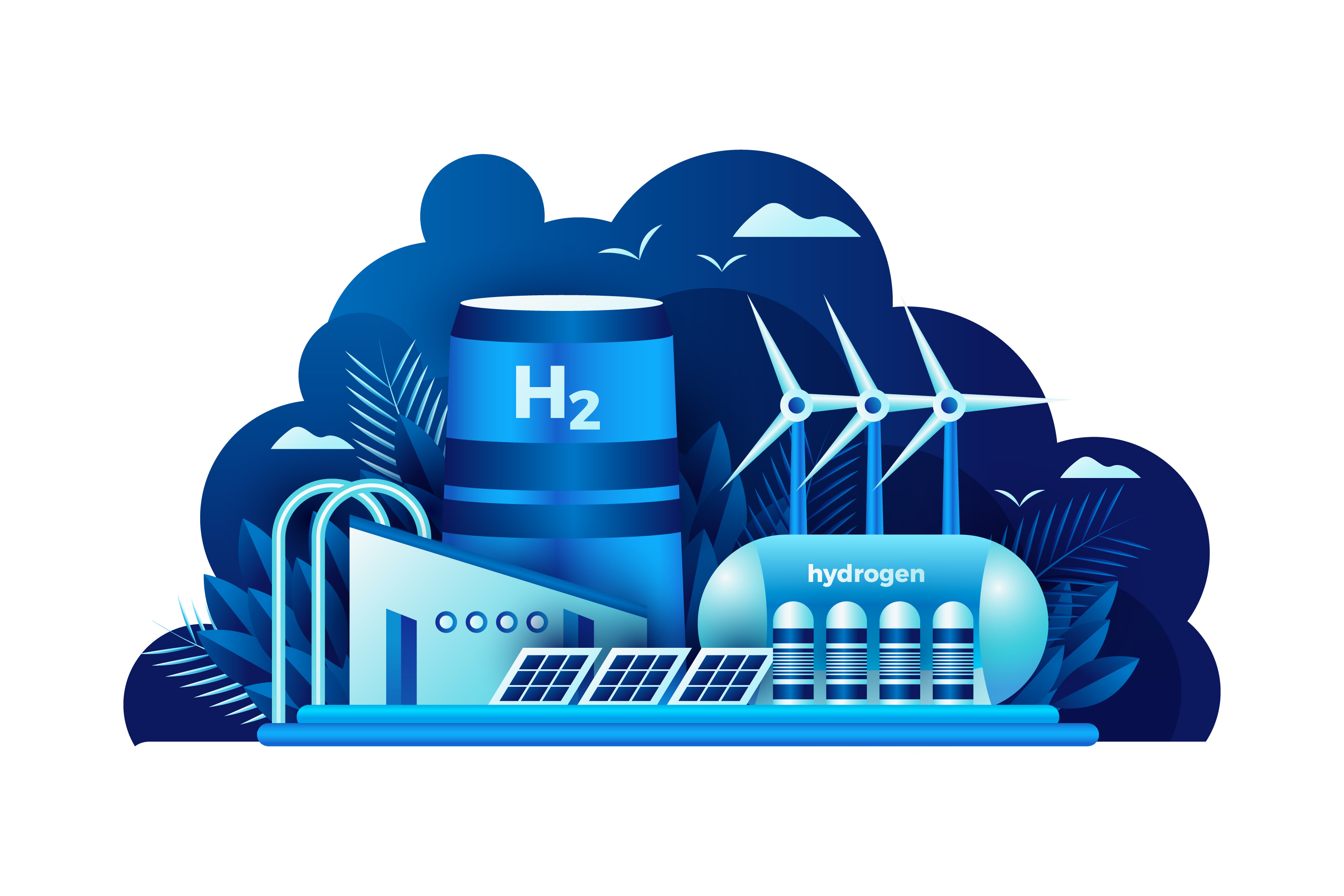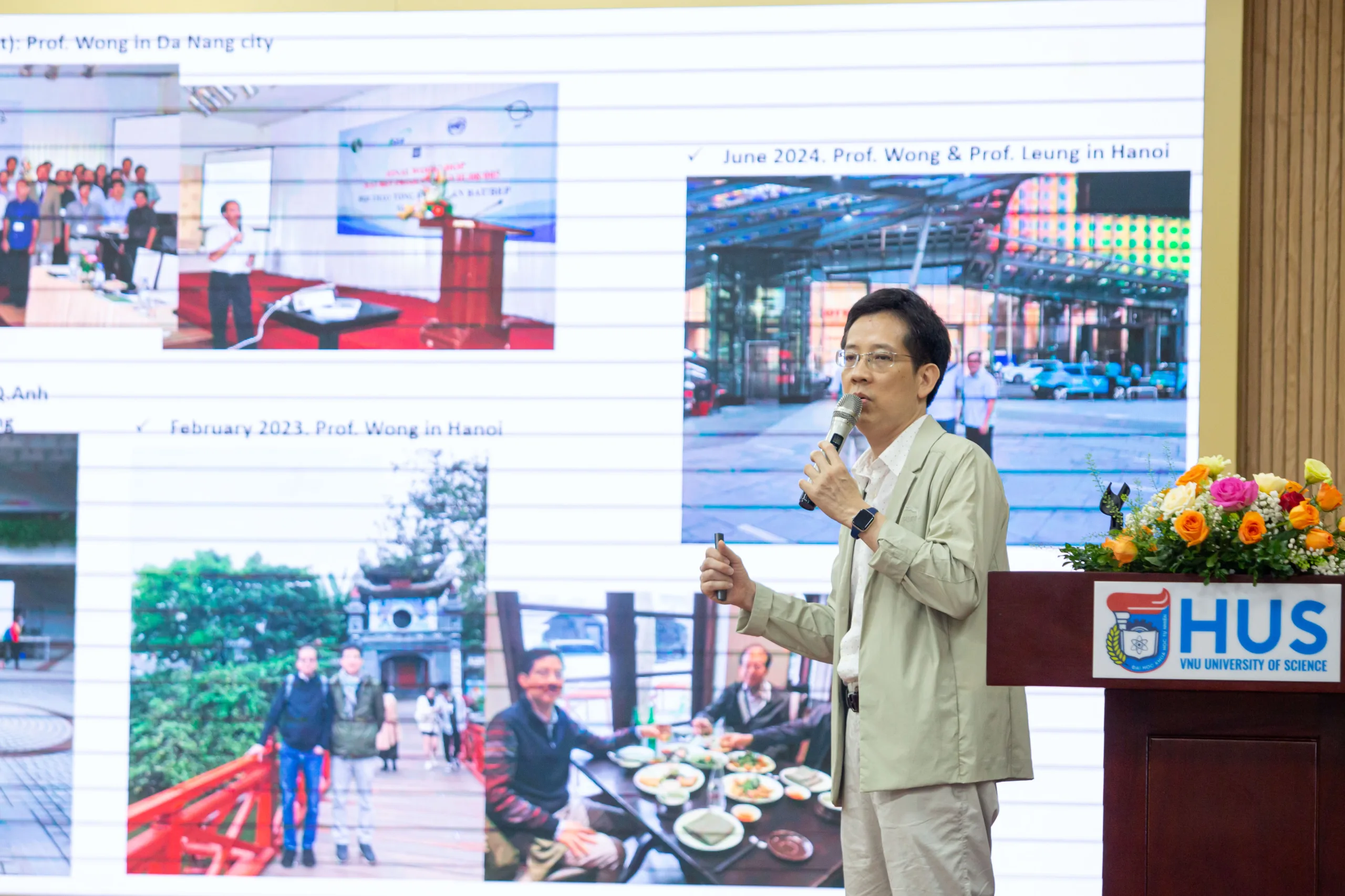The webinar was moderated by Prof. Vivian Yam from the University of Hong Kong (PRC), and the audience was presented with new insights from Prof. Nigel Brandon of Imperial College London (UK), Prof. Kazunari Domen of the University of Tokyo (Japan), and Mr. Ha Dang Son from the Vietnam Low Emission Energy Program II (V-LEEP II). These experts discussed various aspects of the transition to hydrogen.
Hydrogen’s environmental impact
In Prof. Nigel Brandon’s presentation, the audience was taken on an introductory tour of electrolysis technologies, notably to the solid oxide electrolysis (SOEL) of which he described as having an “efficiency to exceed 100%,” although achieving such efficiency remains implausible in reality.
The general idea of SOEL is to raise the temperature to the level where less electricity is needed to split more water. Heat is cheaper than electricity and often available as a by-product of other processes. This presents the opportunity to achieve very high electrical efficiencies. The audience was also introduced to solid oxide fuel cells which use oxide ion-conducting ceramic as an electrolyser. Prof. Brandon gave a concise presentation on three approaches to the designs of the device, with a particular focus on metal-supported cells.
Significant challenges lie ahead for the technology of SOEL, as it remains in an immature state and lacks commercial availability. Nonetheless, Prof. Brandon highlighted that fuel cells, including solid oxide fuel cells (SOFC), have already entered the market, although they currently capture only a small fraction of the global energy industry.
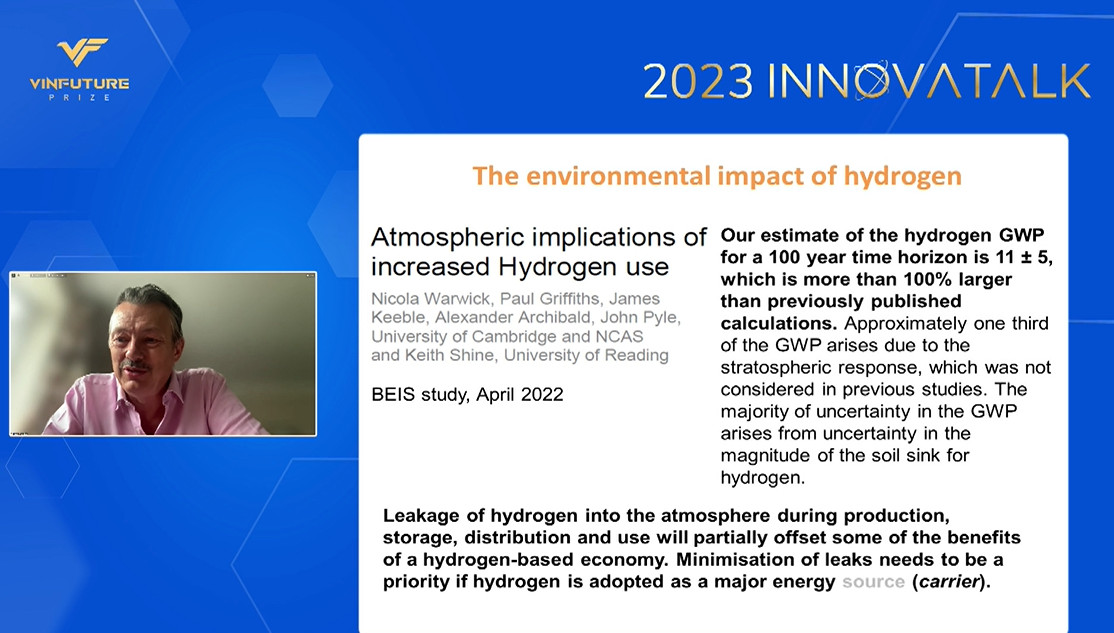
There has also been progress in hydrogen storage capacities made across the globe. One of the noteworthy approaches is to store hydrogen underground in appropriately engineered caverns. An example is a flow battery of which the most conventional type is storing charge in the liquid electrolytes by changing the oxidation state of the electrolyte. It will reduce the agent to perform oxidizing the liquid form of the storage tanks, and by storing more electrolytes in the big tanks will store more energy. This type of technology becomes attractive as we require longer periods of energy storage.
Much as hydrogen is often regarded as an alternative to fossil fuels, it has some environmental impacts too. “We need to build systems that don’t leak, and we need to pay appropriate attention to efficient generation, storage, distribution, and use of hydrogen”, said Prof. Brandon.
Optimizing photocatalysis for splitting water
Professor Kasunari Domen, on his turn, delivered a presentation on Photocatalytic Water Splitting for Solar Hydrogen and Fuel Production. As this type of hydrogen is produced from solar energy and pure water, it can be a clean and sustainable energy carrier as well as a chemical resource, thus becoming one of the most promising energy sources in the future. Unfortunately, the cost of the hydrogen produced by this method is still more expensive than that obtained from fossil resources.
There are several different approaches to splitting water. Technically, the solar cell or photovoltaic and electrolyzer system are now two most realistic systems to convert green hydrogen.
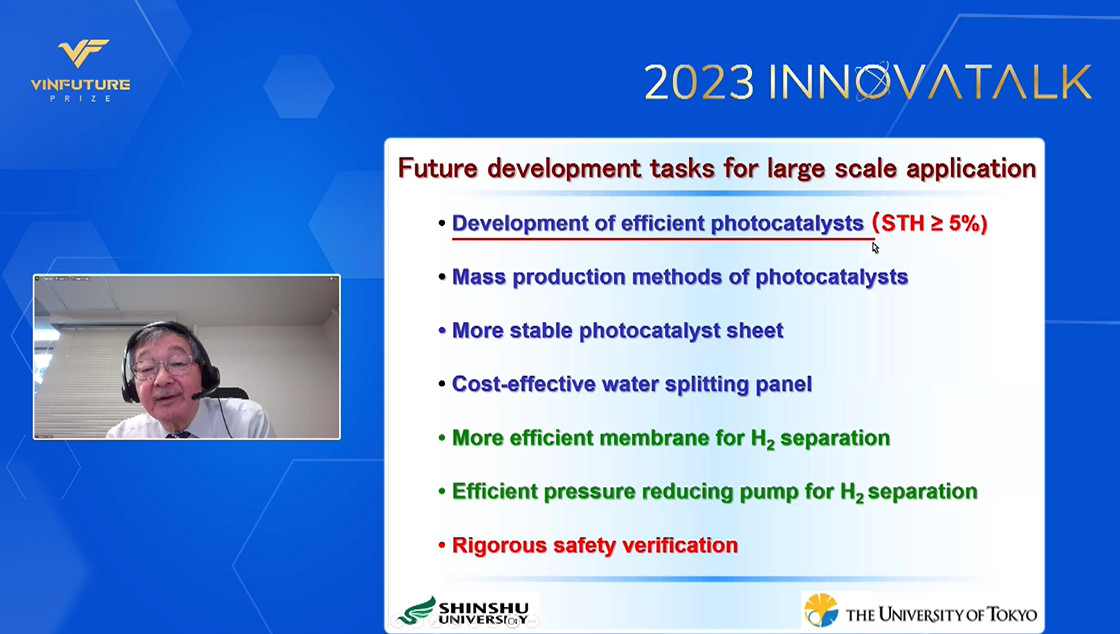
Prof. Domen and his colleagues’ project involved the use of various semiconducting materials for a water splitting reaction. They discovered that, in order to achieve higher solar-to-hydrogen energy conversion efficiency at the laboratory scale, the photoelectrochemical system is easier. However, when it comes to large-scale applications, a challenge arises in term of extending the technology to cover a broader area. On the other hand, photocatalytic reactions are less efficient but offer ease of extension to larger areas.
Prof. Domen’s presentation focused on photocatalysis, exploring ways to apply it to a wide area to produce a large amount of green hydrogen, with the simplest way being to use a water splitting funnel.
Future progress needed for large-scale application of photocatalysis reaction is how to improve the efficiency of the procedure, putting it into mass production, increasing the stability of photocatalyst sheets, and making better splitting panels.
Vietnam’s context: Agenda set but challenges ahead
Considering the context of Vietnam, where energy demand is on a persistent rise and the nation has pledged to achieve a significant environmental goal by 2050, prioritizing the decarbonization of the energy sector becomes paramount. Mr. Ha Dang Son also gave a brief history of energy transition since 1895 when most energy demand was met by traditional biomass. Then came industrialization with the prominence of coal, oil, or gas. Fast forward to 2023, now we’re in the age of green energy transition.
It remains a challenge that the world still relies on coal, especially in the Asia-Pacific area. The solution is to expand renewables such as wind, solar and biogas. It is also recommended to consider gas as the efficient and most efficient intermediary solution to replace coal. Volatility and flexibility are also big issues for the developing country, even the energy security issue. To address these challenges, it’s imperative to explore flexible energy sources, larger-capacity and dispatchable sources. The interplay between flexibility and climate considerations will likely lead to the integration of hydrogen within the gas network.
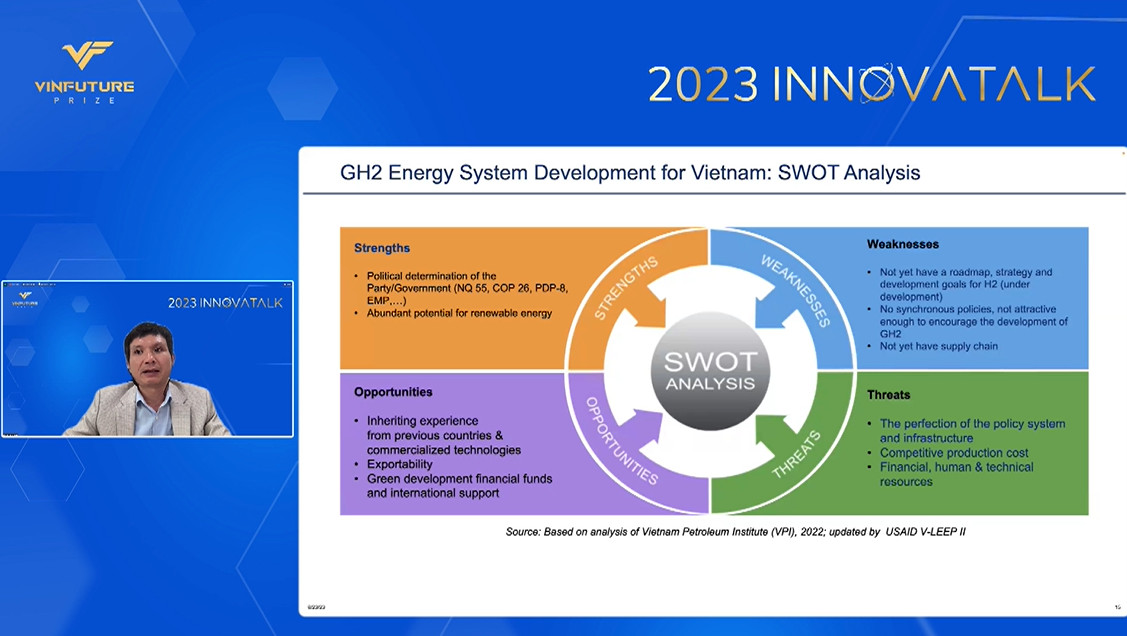
Notably, Vietnam’s existing gas industry exploration and processing infrastructure present a unique opportunity to facilitate this transition. Mr. Ha also reminded the use of the gas industry infrastructure to adapt to the energy transition process in the developing country.
Catching up with the global trends, Vietnam has swiftly risen to become one of the leading countries with a significant share of renewable energy. The Vienamese government has already identified the pathway for green hydrogen, as highlighted in Resolution 55 and the recently approved National Power Development Plan (PDP8) which stressed not only the momentousness of the transition to hydrogen but also conditions to commercialize technology and make prices reasonable.
As green energy has solidified itself as an inevitable trend, funding is expected to increase. However, this growth is not devoid of risks. Potential delays in policy development are likely to occur, subsequently impeding the overall progress of the green hydrogen industry. The challenge lies in determining how we can effectively align resources – including financial, human, and technical resources – with the development of the green industry.
“We got the available technology, the potential or the policy in place. But there are a lot of weaknesses with how we can realize those policies to something like roadmaps, strategy and specific policy and initiative to support the development of green hydrogen in the country”, said Mr. Ha, noting that international support and collaboration on technology transfer and financing are much needed.
Engaging audience
In the Q&A section, Prof. Brandon emphasized the need to see the picture as a whole and to increase the scale of manufacturing. “Hydrogen is a system enabler… Therefore, we have to think about it in the system context. It’s not only about how we make it, but also how we move it, store it and use it as an energy carrier. And how that energy carrier interfaces, whether it’s with liquid fuels, ultimately made from hydrogen, or whether it’s with electricity”, said Prof. Brandon.
As for manufacturing scale, Prof. Brandon cited the lithium-ion battery which is the only electrochemical technology manufactured at a global scale today and also which has received huge investment, resulting in lower cost. There are similar opportunities for electrolyzers, fuel cells and flow batteries, given it receives a similar level of global investment.

Prof. Domen acknowledged the primitivity of his team’s approach on using photocatalysts and the direct water splitting reaction. A major hurdle is to develop the photocatalysts system which can achieve more than 5% solar to hydrogen energy conversion efficiency.
He repeated the need to produce green hydrogen at a low cost, eventually making it competitive to fossil resources. Meanwhile, many countries will keep using the fossil resources as long as the cost of those fossil resources is lower than the cost of other green hydrogen or other renewable energy resources. Desirable progress has been made in the US and Australia where green hydrogen can be generated now at relatively low cost.
“I read some reports that electrolytic hydrogen now costs about 5 to 7 USD/kilogram. And they have a plan to really look forward to eventually moving towards 1 USD/kilogram”, added Prof. Yam.
In the case of Vietnam, Mr. Ha noted that at the moment, the government still maintains a more stable and affordable energy price so that the poor people can still enjoy the energy at an affordable level. But with the adoption of green hydrogen, the cost of energy for different applications could be very high and no longer competitive.
Mr. Ha anticipated that a rapid shift might not materialize within a short span of time but probably from now until 2030 when there should be some revolution with the technology.
Indeed, a glimmer of positivity emerges in the EU countries or other developed countries where there exists a willingness among consumers to buy even more expensive green hydrogen, driven by a profound commitment to sustainability.
